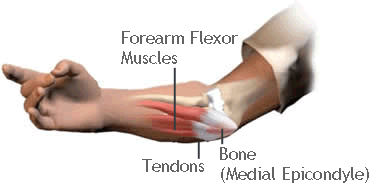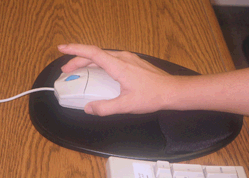|
Tendonitis
Tendonitis is inflammation of the tendons, particularly where they attach a muscle to a bone. They can occur anywhere in the body, but especially in areas that are more prone to excessive stress or cumulative injury.
Probably everyone has had tendonitis at some point in his/her life. The problem nearly always resolves itself if the activity that caused it is temporary. A weekend carpentry project is a good example. However, if the activity and ergonomic risk factors continue, the tendonitis becomes chronic and more difficult to cure.
In chronic cases, the tendon thickens as it tries to repair microscopic tears in the collagen fibers that run lengthwise along the tendon. The tendon actually loses strength and the increased thickness can pull on adjacent structures in the body.
TYPES
Certain types of tendonitis (also spelled, “tendinitis,”) have specific names.

Flexor Tendonitis is inflammation of a flexor tendon, such as the finger tendons that make a fist. We use these for keyboarding and mousing as well as grasping and holding objects. In those affected, pain occurs when grasping or straightening the fingers and can be felt up to the inner part of the elbow, where the tendons originate.
"Clackers" or those who strike the keyboard with excessive force, tend to develop flexor tendonitis in the fingers, wrist or elbow (inner aspect).
Click here to see a video demonstrating striking the keyboard with excessive force.
Extensor Tendonitis is inflammation of an extensor tendon, such as the forearm tendons that hold the back of the hand up. This can be caused by holding the wrists upwards when at the keyboard or lifting heavy objects with palms downward. Discomfort can be anywhere from the back of the wrist to the outside (lateral) aspect of the elbow (the “epicondyle”).
 |
| The most common type of tennis injury is a type of extensor tendonitis called "lateral epicondylitis", caused by excessive top spin on backhand returns. |
 |
| Computer workers can avoid lateral epicondylitis by keeping the wrist level and straight, in the neutral position. Don’t let your wrists drop down onto the wrist rest. Don’t hold your mousing finger up in the air, ready to hit the button. |
DeQuervains Tendonitis is a chronic injury of one or two tendons at the base of the thumb. Common causes are using a hammer or performing similar motion with the wrist bending towards the little finger. This stretches the tendons on the thumb side of the wrist against the carpal bones of the wrist. As the tendons glide over the bony prominence, they are injured. Bending the thumb into the palm and moving the wrist to the side of the little finger is painful. If not corrected, an audible creaking occurs with this movement.
Rotator Cuff Tendonitis is a common problem along the top of the shoulder joint. The rotator cuff is a combined tendon from four muscles in the shoulder blade area of the upper back. It forms a flat arcing ribbon that slips through a small space between the top of the shoulder blade (scapula) and the collar bone (clavicle).
When the tendon thickens from injury, it becomes even more difficult to slip through this slot, thus causing “impingement.” Correct posture is essential to recovery. This means keeping your head over your hips and avoiding reaching forward to mouse or keyboard. Stretch your neck and shoulders frequently.
Pain can be significant when sleeping on one’s side or reaching backwards, such as into the back seat of a car. Surgery should be considered only if several months of physical therapy and removing the cause of the problem fail to ease the pain. | 
